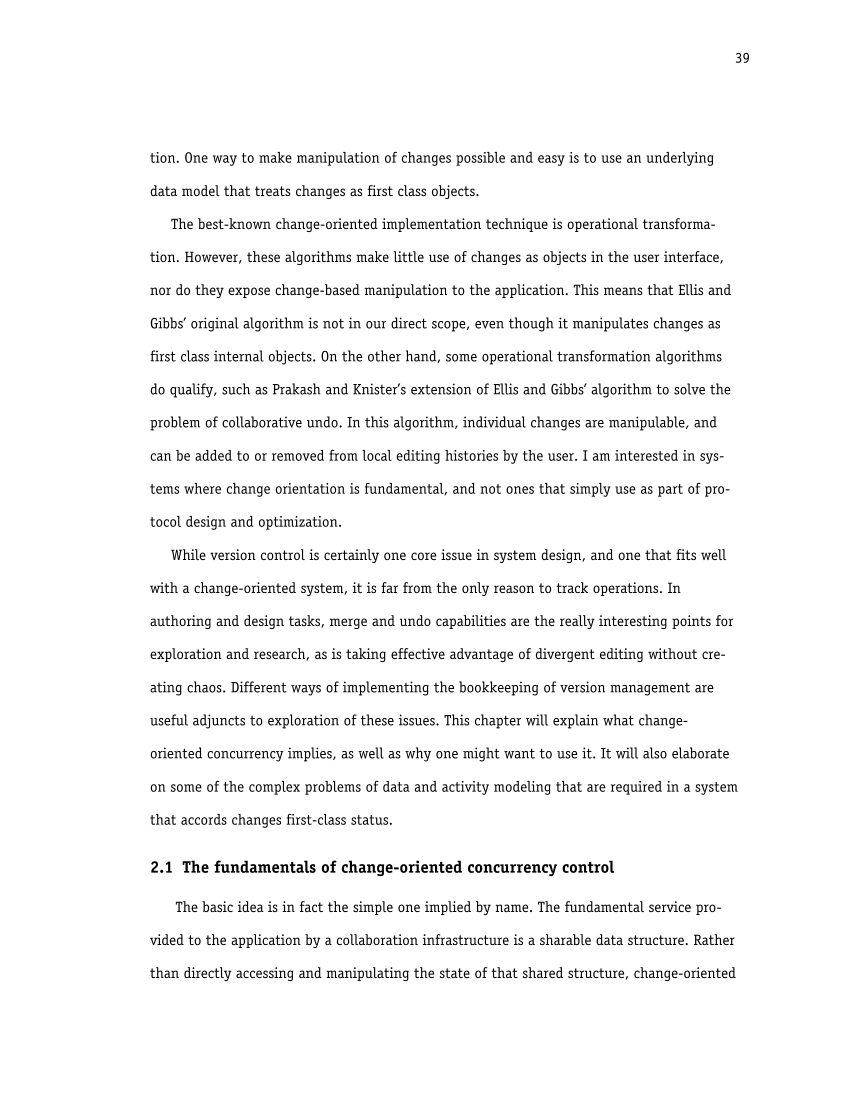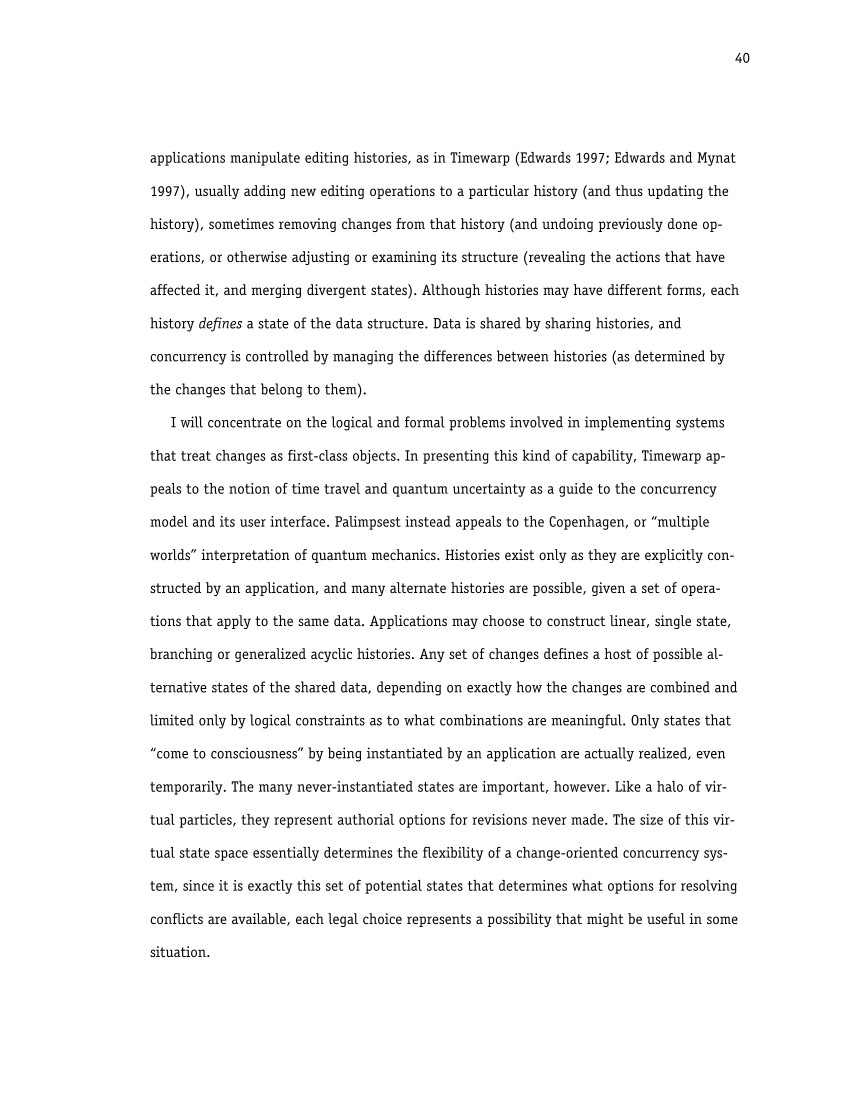39
tion.�One�way�to�make�manipulation�of�changes�possible�and�easy�is�to�use�an�underlying
data�model�that�treats�changes�as�first�class�objects.
The�best-known�change-oriented�implementation�technique�is�operational�transforma-
tion.�However,�these�algorithms�make�little�use�of�changes�as�objects�in�the�user�interface,
nor�do�they�expose�change-based�manipulation�to�the�application.�This�means�that�Ellis�and
Gibbs’�original�algorithm�is�not�in�our�direct�scope,�even�though�it�manipulates�changes�as
first�class�internal�objects.�On�the�other�hand,�some�operational�transformation�algorithms
do�qualify,�such�as�Prakash�and�Knister’s�extension�of�Ellis�and�Gibbs’�algorithm�to�solve�the
problem�of�collaborative�undo.�In�this�algorithm,�individual�changes�are�manipulable,�and
can�be�added�to�or�removed�from�local�editing�histories�by�the�user.�I�am�interested�in�sys-
tems�where�change�orientation�is�fundamental,�and�not�ones�that�simply�use�as�part�of�pro-
tocol�design�and�optimization.
While�version�control�is�certainly�one�core�issue�in�system�design,�and�one�that�fits�well
with�a�change-oriented�system,�it�is�far�from�the�only�reason�to�track�operations.�In
authoring�and�design�tasks,�merge�and�undo�capabilities�are�the�really�interesting�points�for
exploration�and�research,�as�is�taking�effective�advantage�of�divergent�editing�without�cre-
ating�chaos.�Different�ways�of�implementing�the�bookkeeping�of�version�management�are
useful�adjuncts�to�exploration�of�these�issues.�This�chapter�will�explain�what�change-
oriented�concurrency�implies,�as�well�as�why�one�might�want�to�use�it.�It�will�also�elaborate
on�some�of�the�complex�problems�of�data�and�activity�modeling�that�are�required�in�a�system
that�accords�changes�first-class�status.
2.1 The�fundamentals�of�change-oriented�concurrency�control
The�basic�idea�is�in�fact�the�simple�one�implied�by�name.�The�fundamental�service�pro-
vided�to�the�application�by�a�collaboration�infrastructure�is�a�sharable�data�structure.�Rather
than�directly�accessing�and�manipulating�the�state�of�that�shared�structure,�change-oriented
tion.�One�way�to�make�manipulation�of�changes�possible�and�easy�is�to�use�an�underlying
data�model�that�treats�changes�as�first�class�objects.
The�best-known�change-oriented�implementation�technique�is�operational�transforma-
tion.�However,�these�algorithms�make�little�use�of�changes�as�objects�in�the�user�interface,
nor�do�they�expose�change-based�manipulation�to�the�application.�This�means�that�Ellis�and
Gibbs’�original�algorithm�is�not�in�our�direct�scope,�even�though�it�manipulates�changes�as
first�class�internal�objects.�On�the�other�hand,�some�operational�transformation�algorithms
do�qualify,�such�as�Prakash�and�Knister’s�extension�of�Ellis�and�Gibbs’�algorithm�to�solve�the
problem�of�collaborative�undo.�In�this�algorithm,�individual�changes�are�manipulable,�and
can�be�added�to�or�removed�from�local�editing�histories�by�the�user.�I�am�interested�in�sys-
tems�where�change�orientation�is�fundamental,�and�not�ones�that�simply�use�as�part�of�pro-
tocol�design�and�optimization.
While�version�control�is�certainly�one�core�issue�in�system�design,�and�one�that�fits�well
with�a�change-oriented�system,�it�is�far�from�the�only�reason�to�track�operations.�In
authoring�and�design�tasks,�merge�and�undo�capabilities�are�the�really�interesting�points�for
exploration�and�research,�as�is�taking�effective�advantage�of�divergent�editing�without�cre-
ating�chaos.�Different�ways�of�implementing�the�bookkeeping�of�version�management�are
useful�adjuncts�to�exploration�of�these�issues.�This�chapter�will�explain�what�change-
oriented�concurrency�implies,�as�well�as�why�one�might�want�to�use�it.�It�will�also�elaborate
on�some�of�the�complex�problems�of�data�and�activity�modeling�that�are�required�in�a�system
that�accords�changes�first-class�status.
2.1 The�fundamentals�of�change-oriented�concurrency�control
The�basic�idea�is�in�fact�the�simple�one�implied�by�name.�The�fundamental�service�pro-
vided�to�the�application�by�a�collaboration�infrastructure�is�a�sharable�data�structure.�Rather
than�directly�accessing�and�manipulating�the�state�of�that�shared�structure,�change-oriented





























































































































































































